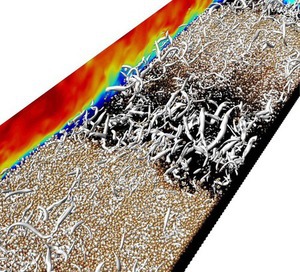The formation of sediment patterns is a common occurrence in river and marine flows as well as in various technical applications involving shear flow over a bed of mobile sediment particles. The process of erosion of particles from the sediment layer and their deposition at certain preferential locations often leads to bed shapes which are commonly described as ripples or dunes. From an engineering point of view it is highly desirable to be able to predict the occurrence and the nature of this phenomenon, since the bedform significantly influences flow characteristics such as resistance, mixing properties and sediment transport.
These modified flow quantities in turn have far-reaching consequences for the operation of diverse facilities in hydraulics, chemical engineering, etc.

The objective of this project is to contribute to the elucidation of the physical mechanisms involved in the formation of sediment patterns driven by (turbulent) shear flow. To this end we are simulating the development of subaqueous bedforms by means of high-fidelity numerical simulations which resolve all the relevant length and time scales of the turbulent flow as well as the individual sediment particles.
[1] Kidanemariam, A.G., Uhlmann, M. Direct numerical simulation of pattern formation in subaqueous sediment. J. Fluid Mech., 750:R2, 2014.[DOI]
[2] Colombini, M., A decade's investigation of the stability of erodible stream beds, J. Fluid Mech., 765:1-4, 2014 [DOI]
[3] Kidanemariam A.G., Uhlmann, M., Interface-resolved direct numerical simulations of the erosion of a granular bed sheared by laminar channel flow. Int. J. Multiphase Flow, 67:174-188, 2014 [DOI]